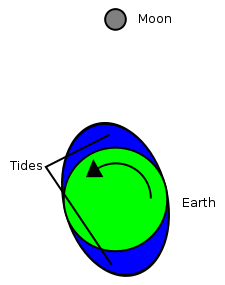The Battle of the Bulge
I’m going back a bit in time here to revisit the first episode of Cosmos from a couple of weeks ago. At one point in that show, host Neil deGrasse Tyson mentioned that the earth and moon were much closer to each other when they were cutting their planetary baby teeth. Then he said something about the moon being pushed away from the earth by tidal friction and LEFT IT AT THAT! No explanation. No computer animation. Nothing. The thought must not have crossed his mind that millions of viewers out there in TV land would be left tossing and turning through sleepless nights wondering, What the heck is tidal friction? (Okay, that may be a bit of an exaggeration. Maybe it was just me tossing and turning and maybe it was only seven minutes before I fell asleep.)
Friction occurs between water tides and sea bottoms, particularly where the sea is relatively shallow, or between parts of the solid crust of planet or satellite that move against each other. Tidal friction on the Earth prevents the tidal bulge, which is raised in Earth’s seas and crust by the Moon’s pull, from staying directly under the Moon. Instead, the bulge is carried out from directly under the Moon by the rotation of the Earth, which spins almost 30 times for every time the Moon revolves in its orbit. The mutual attraction between the Moon and the material in the bulge tends to accelerate the Moon in its orbit, thereby moving the Moon farther from Earth by about three centimeters (1.2 inches) per year, and to slow Earth’s daily rotation by a small fraction of a second per year.
In short, the presence of the tides caused by the moon on the earth are pushing the moon away from the earth and slowing the earth’s rotation. So every day, month, and year is just a little bit longer than the one before it and the moon is just a little bit farther away.

